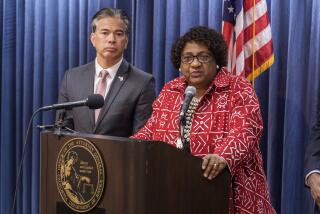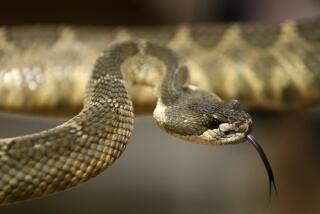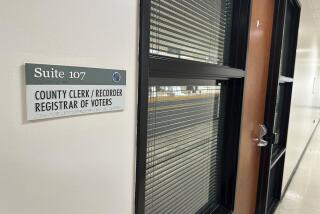Tainted Letter Opened With Care
- Share via
WASHINGTON — Specially trained FBI scientists on Wednesday surgically opened an anthrax-tainted letter sent to Sen. Patrick J. Leahy (D-Vt.) and began extracting evidence they hope will lead them to the person who launched a bioterrorism attack by mail more than two months ago.
The FBI believes the Leahy letter, as well as three other contaminated letters, may have been sent by a man operating alone in the United States. The attack has been blamed for five deaths and at least 13 illnesses in recent months.
An FBI hazardous material expert close to the investigation said the experts examining the letter believe the envelope will contain the same type of expertly processed anthrax that was discovered in a letter sent to Sen. Tom Daschle (D-S.D.).
The scientific team, which includes officials from the Atlanta-based Centers for Disease Control and Prevention, also anticipates that the enclosed letter will bear the same anti-American message contained in other anthrax mailings, including ones sent to Daschle, NBC News anchor Tom Brokaw and the New York Post.
FBI officials could not confirm late Wednesday if the opening of the envelope, a delicate procedure they had been planning for weeks, had been completed. They declined to say how long the process was expected to take. The work was being done at the Army’s Medical Research Institute for Infectious Diseases at Ft. Detrick, Md.
The Leahy letter would be opened in a “controlled, secure and sterile environment in which it is necessary to control motion and air pressure,” an FBI officials said.
After the deadly anthrax powder is removed, it will be sent to various labs for analysis, officials said.
The Leahy and Daschle letters were processed in the same New Jersey mail facility on Oct. 9 and bear similar block lettering and an identical return address. Anthrax spores that leaked from the Leahy letter, found nearly a month ago in quarantined Capitol Hill mail, also appear to be the same kind of finely milled anthrax that made the Daschle letter so potent, officials have said.
But in interviews late Wednesday, the hazardous material expert and other FBI officials, who asked to remain anonymous, said the Leahy letter was far more promising as an investigative tool.
They said it could provide a wealth of clues, mostly due to the large quantity of anthrax spores it appears to contain. They hope to run a wide variety of tests on the bacteria, including comparing them to the spores contained in other anthrax-laden letters as well as a national databank of anthrax specimens.
The letter sent to Daschle was opened before the danger was apparent, and most of the anthrax spores escaped before scientists were given a chance to analyze them, FBI officials said.
Authorities also hoped to gain more forensic evidence from the Leahy letter, including clues from the handwriting, the message and perhaps fingerprints and DNA evidence from traces of saliva or bits of skin that may have been left by the sender.
The FBI scientists have spent several weeks making sure conditions were ideal before beginning the process of opening the heavily sealed and taped envelope sent to Leahy.
Because the spores could be electrostatically charged, scientists were planning on gently waving a specially charged metal rod over them. That would attract the microscopic particles much like a magnet attracts metal filings, and keep them from flying away, the hazardous material expert said.
“We have been deliberate and methodical, the FBI and other government scientists, in developing a protocol to open the letter,” said one FBI official. “We consulted with outside experts, and during the entire process the concern has been the safety of the scientists involved. But we must also be careful in that we can develop a prosecutable case with the forensic evidence that is obtained.”
More to Read
Sign up for Essential California
The most important California stories and recommendations in your inbox every morning.
You may occasionally receive promotional content from the Los Angeles Times.










